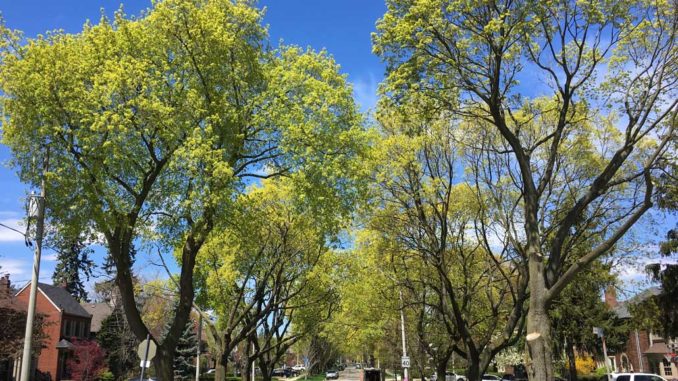
Studies show a direct correlation between the wellbeing of our city and the strength of our urban forest. When our tree canopy thrives, Toronto is a healthier, more livable and resilient city.
Trees improve the livability of a city in countless ways. Aesthetically, they beautify our neighbourhoods, making communities like Leaside an even more attractive place to live. Trees are also the lungs of our city, providing benefits like enhanced air quality and smog reduction. Toronto’s trees store 1.1 million metric tonnes of carbon, which is equivalent to the yearly carbon emissions from over 700,000 automobiles. They also improve stormwater management. It’s estimated that every 5% of tree cover in a community reduces stormwater runoff by 2%.
During a hot Toronto summer, our tree canopy provides a much-needed cooling effect by offering shade and transpiring water. Many metropolitan areas are at risk of experiencing the urban heat island effect, which happens when the densely packed buildings and paved surfaces that make up our downtown core trap heat and cause the city to warm. Trees have proven to be an efficient and cost-effective method of alleviating the urban heat island effect.
Ward 15 is home to one of the densest tree canopies in all of Toronto. As our city continues to grow, I will maintain my support of policies that protect our urban forest and greenspaces for future generations.
In all of Toronto, we’re fortunate to have one of the densest urban tree canopies in the world. A recent study conducted by the Massachusetts Institute of Technology (MIT) estimated that 19.5% of our land is part of the urban forest. The City’s own inventory estimates that there are 10.2 million trees in Toronto – 4.1 million of which are located in parks and ravines or along streets.
As your city councillor, protecting our urban tree canopy remains one of my top priorities. One of my first motions as a newly-elected councillor directed staff to prioritize tree preservation while conducting environmental assessments. I spearheaded the creation of a comprehensive tree protection framework that requires City crews to use cutting-edge technologies and hand-dig while working in proximity to trees. Additionally, I asked staff to develop a strategy to minimize the number of trees impacted by major construction projects.
I’ve also launched new initiatives to better integrate tree-related considerations in the planning and development process, standardize the criteria used to evaluate the health of a tree, and strengthen enforcement of the tree bylaws by increasing fines and issuing stop-work orders to developers who are not in compliance.
In 2013, you’ll recall that Toronto was hit by an ice storm that decimated our tree canopy. City staff estimate that roughly 20% of the urban forest was lost to the storm. In the months following, I successfully introduced motions at City Council requesting an updated pruning and maintenance strategy that would reduce the vulnerability of city trees to future ice storms and repair the damage sustained. I will continue to work to protect the city’s – and Leaside’s – extensive tree canopy.


